 |
| Photo of broken chain by shilmar at https://pixabay.com/photos/portsoy-scotland-port-historical-1244583/ |
U.S. History Week 16
The Era of Reconstruction, 1865-1877
I designed a quiz related to chapter 16 at the bottom of this article.
Directions for the quiz:
- Scroll down & click on the first thumbnail to enlarge to full screen.
- Choose an answer for each question.
- Click on the graphic to advance to the next screen.
- The correct answer is on the screen following the question.
- Compare your answers with those provided.
- If you cannot easily see the correct answer, check the captions.
An interactive version is available on Kahoot!
Search for this week’s topic by Katrena to find it.
Review the following Chapter 16 pages:
- Introduction
- Restoring the Union
- Congress and the Remaking of the South, 1865-1866
- Radical Reconstruction, 1867-1872
- The Collapse of Reconstruction
- Key Terms
- Summary
Practice learning Chapter 16 Key Terms on Quizlet.
Week 16 Videos:
- Three Reconstruction Plans (15:20)
- Lincoln’s Assassination Devastates the Nation (15:49)
- The Civil Rights Act of 1866 (4:15)
- Crash Course: Equal Protection (14th Amendment) (8:15)
- History Channel: The 15th Amendment (1:50)
- Crash Course: Reconstruction and 1876 (12:59)
- Crash Course: Reconstruction Black American History (13:58)
Review the following information featuring the U.S.:
- Missouri (7:21)
- Montana (6:12)
- Benjamin Harrison: Cold Man in the White House
- Caroline Lavinia Scott Harrison: White House Artist
- William McKinley: The Carnation Story
- Ida Saxton McKinley’s Slippers
Additional Resources:
Thanks for visiting my Student Survive 2 Thrive blog!
Find additional resources through my site map, topics tabs, or search bar.
Here are some of my articles you may find helpful this week:
 |
| U.S. History Week 16 The Era of Reconstruction 1865-1877 |
 |
| Created by Katrena All rights reserved. |
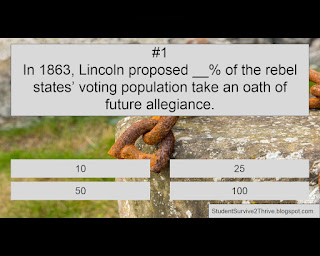 |
| In 1863, Lincoln proposed __% of the rebel states’ voting population take an oath of future allegiance. Answer choices include: 10, 25, 50, 100 |
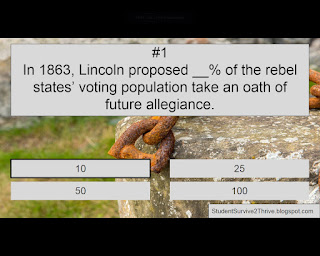 |
| The correct answer is 10. |
 |
| Which constitutional amendment abolished slavery? Answer choices include: 1, 5, 9, 13 |
 |
| The correct answer is 13. |
 |
| How did President Abraham Lincoln die? Answer choices include: He died of food poisoning. He was shot in a theater. He fell off a horse & broke his neck. He died of pneumonia. |
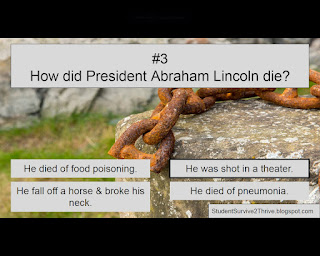 |
| The correct answer is: He was shot in a theater. |
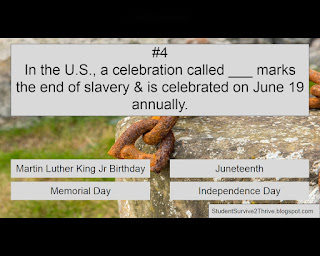 |
| In the U.S., a celebration called ___ marks the end of slavery & is celebrated on June 19 annually. Answer choices include: Martin Luther King Jr Birthday, Juneteenth, Memorial Day, Independence Day |
 |
| The correct answer is Juneteenth. |
 |
| The correct answer is: He fought for formerly enslaved people to vote. |
 |
| The Freedman’s Bureau provided assistance to people in the South through __. Answer choices include: establishing public schools, help with gaining labor contracts, food deliveries, all of these |
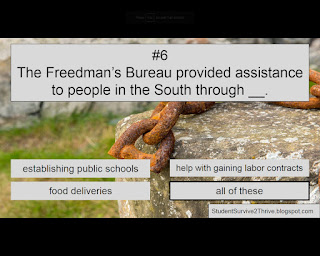 |
| The correct answer is all of these. |
 |
| Discriminatory policies focused on White supremacy abounded in the South and were called ___. Answer choices include: Brown Codes, Supreme Codes, White Codes, Black Codes |
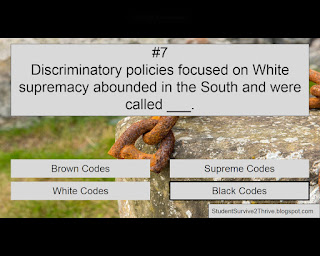 |
| The correct answer is Black Codes. |
 |
| Which former Confederate state ratified the 14th Amendment in 1866? Answer choices include: Alabama, Virginia, Tennessee, Louisiana |
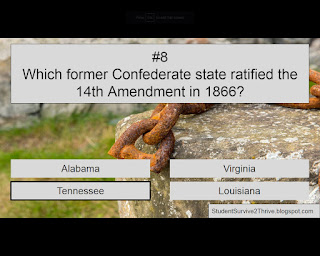 |
| The correct answer is Tennessee. |
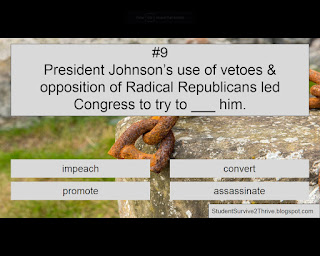 |
| President Johnson’s use of vetoes & opposition of Radical Republicans led Congress to try to ___ him. Answer choices include: impeach, convert, promote, assassinate |
 |
| The correct answer is impeach. |
 |
| The 15th Amendment left out issues related to ___. Answer choices include: race, previous condition of servitude, literacy tests & poll taxes, color |
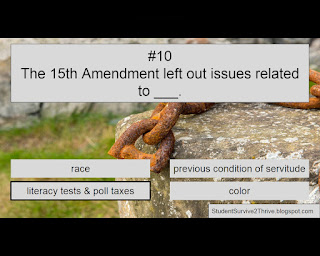 |
| The correct answer is literacy tests & poll taxes. |
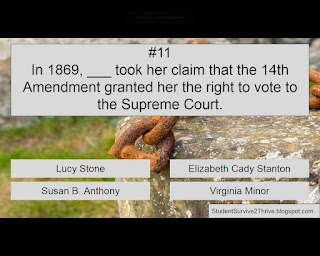 |
| In 1869, ___ took her claim that the 14th Amendment granted her the right to vote to the Supreme Court. Answer choices include: Lucy Stone, Elizabeth Cady Stanton, Susan B. Anthony, Virginia Minor |
 |
| The correct answer is Virginia Minor. |
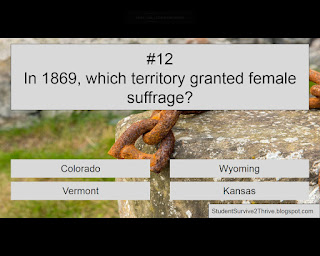 |
| In 1869, which territory granted female suffrage? Answer choices include: Colorado, Wyoming, Vermont, Kansas |
 |
| The correct answer is Wyoming. |
 |
| Political clubs, ___, provided information & mentors, campaigns, and helped build schools & churches. Answer choices include: Union Leagues, Confederate Leagues, Big Leagues, American Leagues |
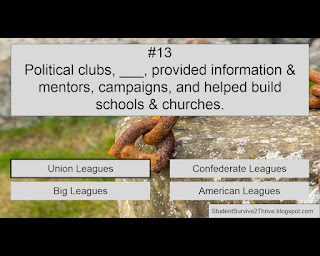 |
| The correct answer is Union Leagues. |
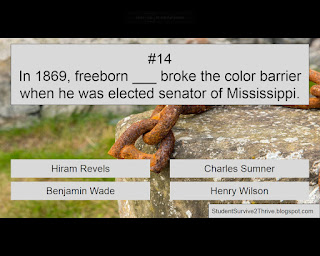 |
| In 1869, freeborn ___ broke the color barrier when he was elected senator of Mississippi. Answer choices include: Hiram Revels, Charles Sumner, Benjamin Wade, Henry Wilson |
 |
| The correct answer is Hiram Revels. |
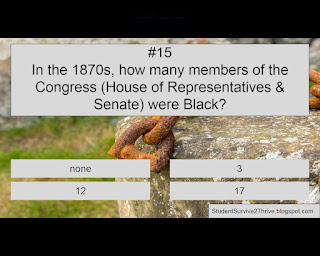 |
| In the 1870s, how many members of the Congress (House of Representatives & Senate) were Black? Answer choices include: none, 3, 12, 17 |
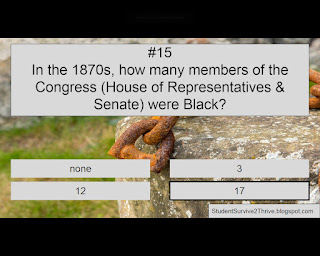 |
| The correct answer is 17. |
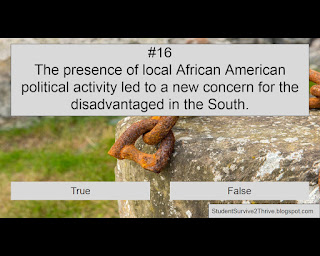 |
| The presence of local African American political activity led to a new concern for the disadvantaged in the South. Answer choices include: true, false |
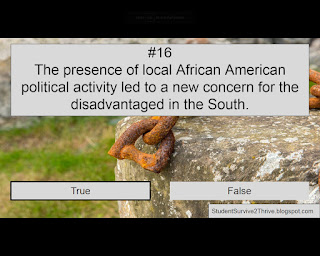 |
| The correct answer is true. |
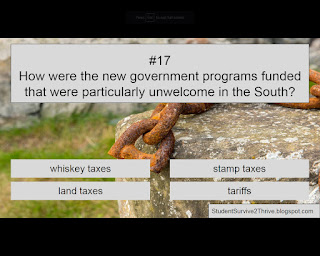 |
| How were the new government programs funded that were particularly unwelcome in the South? Answer choices include: whiskey taxes, taxes, stamp taxes, land taxes, tariffs |
 |
| The correct answer is land taxes. |
 |
| The most noted domestic terror organization of the American Reconstruction era was the ___. Answer choices include: Taliban, Ku Klux Klan, al Quaeda, Hamas |
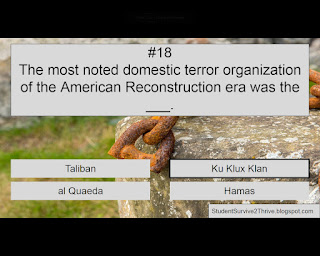 |
| The correct answer is Ku Klux Klan. |
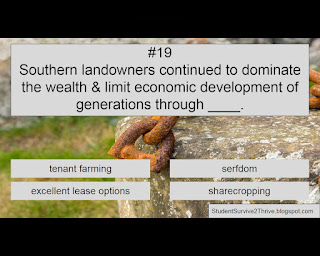 |
| Southern landowners continued to dominate the wealth & limit economic development of generations through ____. Answer choices include: tenant farming, serfdom, excellent lease options, sharecropping |
 |
| The correct answer is sharecropping. |
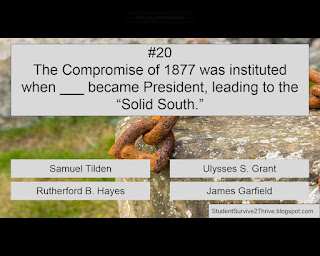 |
| The Compromise of 1877 was instituted when ___ became President, leading to the “Solid South.” Answer choices include: Samuel Tilden, Ulysses S. Grant, Rutherford B. Hayes, James Garfield |
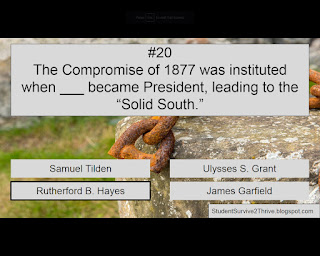 |
| The correct answer is Rutherford B. Hayes. |
 |
| Find more resources at StudentSurvive2Thrive.blogspot.com |
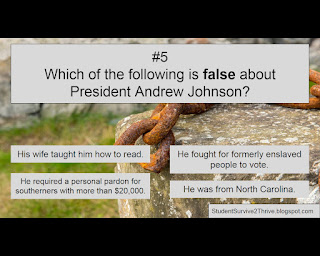
No comments:
Post a Comment
Thanks for reading my article and sending your comment! Please note that I do not place links to other web sites on this blog.
Note: Only a member of this blog may post a comment.